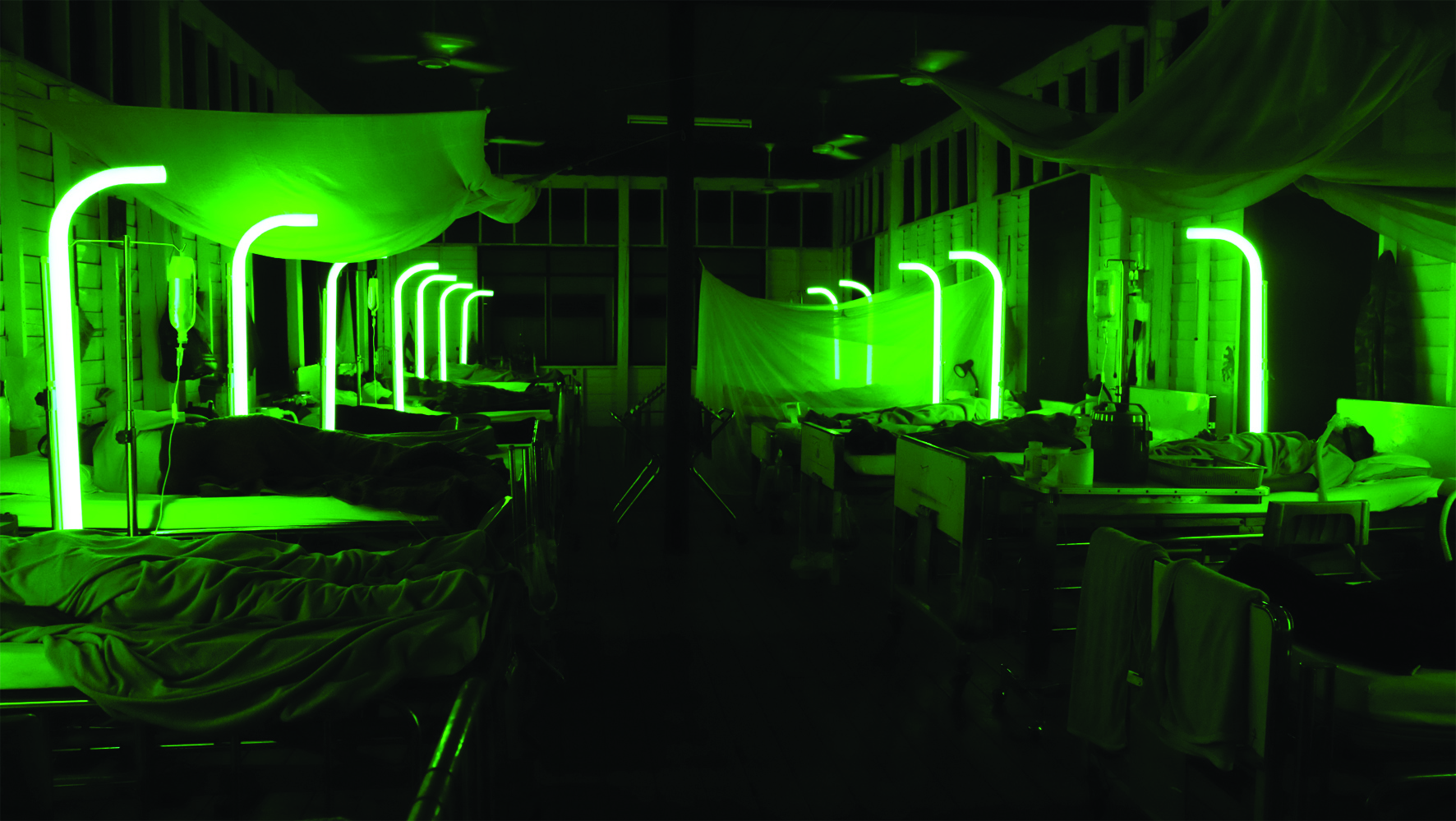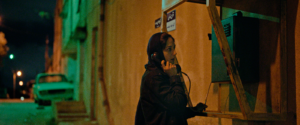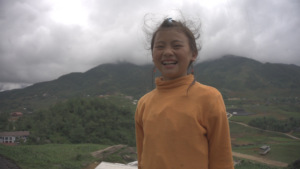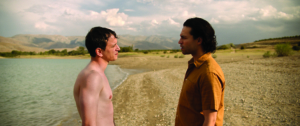‘Please focus on the present’ is the polite injunction made shortly into Cemetery of Splendour. As posed, the request seems like simplicity itself but, like the film, its becalmed exterior conceals a host of deeper currents. Cemetery, which premiered at the Cannes Film Festival in 2015, is the latest feature from Thai director Apichatpong Weerasethakul, whose earlier film Uncle Boonmee Who Can Recall His Past Lives won the Palme d’Or in 2010. Like Boonmee, the new film presents a calmly meditative inquiry into the intersection of the natural and supernatural realms.
Cemetery takes place in and around a makeshift clinic in Khon Kaen (the director’s own home town), which has been set up to accommodate a group of soldiers who are suffering from a mysterious sleeping sickness. Among the nurses, volunteers and family members, one recurring visitor is a woman named Keng (Jarinpattra Rueangram), who is said to be a medium, and who performs readings of the soldiers’ mental states for their families. In one reading, while Keng is mediating a discussion between a sleeping soldier and his mother, she abruptly loses the thread of the conversation, explaining – in one of Weerasethakul’s many casually Buddhist flourishes – that she has involuntarily gone back into the man’s past life. This leads the soldier’s mother to suggest that Keng focus on present concerns, such as what the soldier needs to eat (soup with mince) and how spicy it should be (‘two chillies’ is the answer). Keng seems to take her work as a medium seriously, but neither the film nor its characters accord any particular sense of wonder to her gifts. In one scene, Keng – while commiserating with Jen (Jenjira Pongpas Widner, a recurring player for Weerasethakul), a middle-aged volunteer at the clinic – even suggests that many family members are just as interested in getting a tip on lottery numbers as they are in the soldiers’ psychic health.
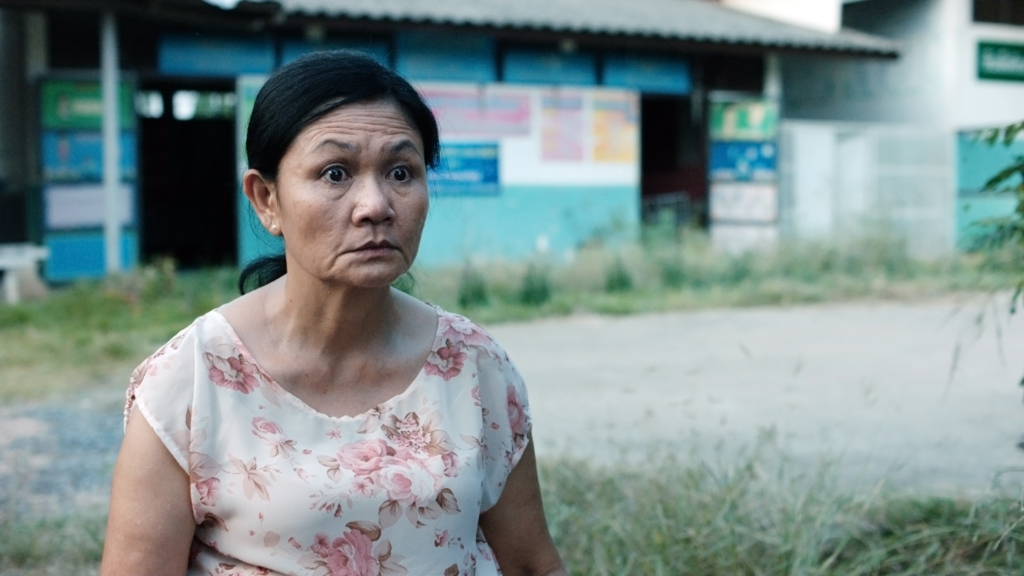
The casual, even absurd, combination of the everyday and the spiritual, as seen in these moments, is emblematic of the distinctive tonalities that mark the director’s work; Weerasethakul operates in a magic-realist mode that is sometimes indistinguishable from realism. In Boonmee, spirits of the titular character’s dead family members return to gather around him in his dying days; one of them, his lost son, manifests as a pitch-black furry creature with glowing red eyes. The family accepts this new form – and, indeed, his very presence – with equanimity. In Cemetery, even such cosmetic flourishes denoting supernatural elements are eschewed. When two local goddesses appear to Jen to explain the cause behind the soldiers’ sickness, for instance, they arrive in the form of two ordinary urban shoppers.
What little narrative Cemetery has revolves around Jen, who develops a close relationship with one of the soldiers, Itt (Banlop Lomnoi), during his occasional waking hours. Jen learns from the goddesses that the soldiers are in thrall to a host of dead ancient kings, on whose burial ground the clinic stands, who use the soldiers’ energies to fight ghostly battles in the afterlife. Much of the final third of the film is taken up by an extended walk through a park near the clinic, during which Keng, channelling the spirit of the sleeping Itt, describes to Jen the ancient palace that once occupied its grounds. In Cemetery, the past always underlies the present, and the two flow together with dream-like ease.
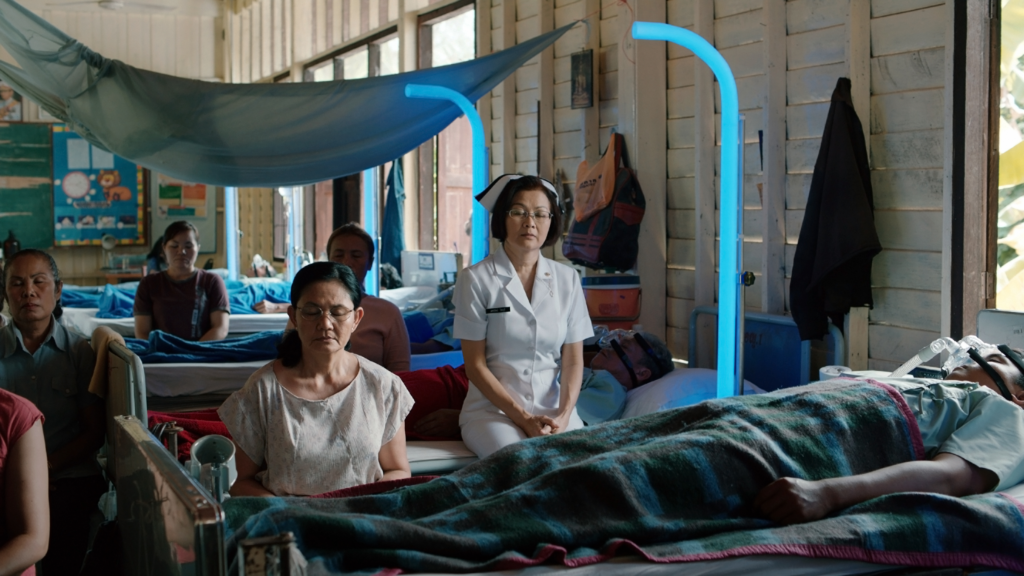
This past–present slippage has been a recurring feature of Weerasethakul’s cinema – Boonmee, as its full title suggests, is intimately concerned with the reality of past lives, for instance. But, in Cemetery, this persistent theme quietly assumes new forms and prominence. One of the ways the director articulates this is through the use of repurposed spaces: the soldiers’ clinic, formerly a school, still has blackboards hanging on the walls of their dorms; other rooms contain the detritus of past class materials. When Jen first visits the clinic, she finds that Itt’s bed occupies the same space she once sat in as a child, from where she struggled to read the blackboard. Having learned about the ancient kings who steal the soldiers’ energies, Jen speculates that their presence must have been why she used to get so sleepy in class.
In Cemetery, the past always underlies the present, and the two flow together with dream-like ease. This past–present slippage has been a recurring feature of Weerasethakul’s cinema.
This idea of psychic recurrence has an intertextual element, too, since Cemetery is a partial revisiting of the themes and situations in Weerasethakul’s Syndromes and a Century (2006). That film, which was initially conceived as a semi-biographical reflection on the lives of his parents,[1]Thunska Pansittivorakul, ‘A Conversation with Apichatpong Weerasethakul’, Criticine, 29 April 2006, <http://www.criticine.com/interview_article.php?id=24>, accessed 19 February 2016. who were physicians in Khon Kaen, follows a two-part structure, with scenarios and characters from the first half revisited and replicated in the second. In the earlier half, a young male doctor is interviewed by a female physician at a rural hospital for a placement there. Later, having accepted the job, he professes his love for her, to which she responds with an extended story about how she herself once fell for an orchid farmer. In a parallel thread, a dentist at the hospital treats a Buddhist monk, in whom he comes to see the reincarnated spirit of his dead brother. The second half begins in much the same way, but with the action now taking place at a sleekly modern, urban hospital. The three characters recur, but their paths diverge, and the hospital basement is now a site for the treatment of wounded soldiers.
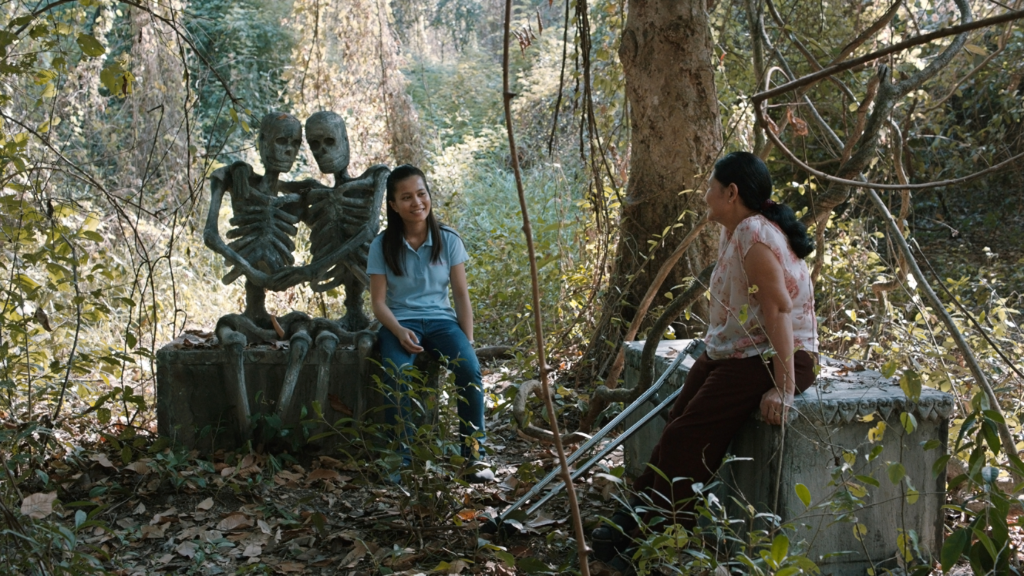
As it proceeds, Cemetery accrues a collection of resonances with this earlier film. The clinic, with its broad windows and airy rooms, has the same feel as the rural hospital in Syndromes. The welfare of soldiers is a repeated concern – in both films, a program of guided meditation is enacted as a method of treatment. In Cemetery, Jen points out a community garden of orchids on their tour through the park, highlighting how the same actress played the part of the orchid-grower’s assistant in Syndromes. These recurrences could just be seen as evidence of Weerasethakul’s auteurist predilections, but the biographical significance of the Khon Kaen setting – Cemetery’s Thai title, Rak ti Khon Kaen, translates to ‘Love in Khon Kaen’ – suggests that the same intimacy that seems to run through Syndromes permeates Cemetery as well. In interviews, Weerasethakul has said that the film will be his last Thai production due to political restrictions enforced on the country’s film industry.[2]Apichatpong Weerasethakul, quoted in Amir Ganjavie, ‘A Homeland Swansong: Apichatpong Weerasethakul on Cemetery of Splendor’, Senses of Cinema, issue 77, December 2015, <http://sensesofcinema.com/2015/feature-articles/apichatpong-weerasethakul-interview/>, accessed 19 February 2016. Indeed, Syndromes encountered controversy when it became the first film to be censored by the Thai state following a 2006 military coup.[3]Genevieve Yue, ‘Light of the Century’, Reverse Shot, 27 December 2009, <http://reverseshot.org/symposiums/entry/9/5_syndromes_and_century>, accessed 19 February 2016. The same political troubles that disturbed the release of Syndromes swirl beneath the otherwise-placid surface of Century, the release of which followed a new period of political turmoil in Thailand, which underwent another military coup in 2014.[4]Chico Harlan & Lennox Samuels, ‘Thai Military Declares a Coup, Detains Key Political Leaders’, The Washington Post, 22 May 2014, <https://www.washingtonpost.com/world/asia_pacific/thai-military-declares-a-coup-detains-key-political-leaders/2014/05/22/5da6a6ca-e1a0-11e3-8dcc-d6b7fede081a_story.html>, accessed 19 February 2016.v In a Variety review published after the film’s premiere at Cannes, Justin Chang wrote that ‘it’s no huge leap to interpret the sleeping soldiers as a stand-in for a government paralyzed by protests, coups and other outbreaks of violence’.[5]Justin Chang, ‘Cannes Film Review: Cemetery of Splendor’, Variety, 18 May 2015, <http://variety.com/2015/film/asia/cemetery-of-splendor-review-cannes-apichatpong-weerasethakul-1201499533/>, accessed 19 February 2016.
Weerasethakul has spoken about how the inhibiting effects of military rule (including the spectres of interrogation and prosecution) have meant that aspects of his cinema have to be articulated in a ‘coded’ form. Of Cemetery, he says:
This is a movie of resistance but it can simultaneously be something of an escapist movie, too. You can look at it from different angles. It could be the start of something that you can Google later, but for me I do not think about what amount of information the audience will ‘get’.[6]Weerasethakul, quoted in Ganjavie, op. cit.

Viewers unfamiliar with the recent history of political unrest in Thailand might be forgiven for not absorbing Cemetery’s more troubling undercurrents, given the film’s somnolent aesthetic. A lot of this is to do with Weerasethakul’s hypnotic style. In his review, Chang situates the director’s aesthetic within the ‘slow cinema’ movement[7]Chang, op. cit. – a characterisation that captures the effect of Weerasethakul’s technique, but perhaps not its substance. Shot duration in Cemetery is shorter than other recent ‘slow cinema’ works such as Filipino director Lav Diaz’s Norte, the End of History (2013), and, although Weerasethakul’s film unfolds leisurely over its two hours, the editing by Lee Chatametikool proceeds at a crisp pace. First-time Weerasethakul cinematographer Diego Garcia, keeping up with the director’s earlier work, frames action at a considered distance, contributing to the film’s measured feel.
But key to Cemetery’s overall distinctive affect is its immersive sound design, here credited to Akritchalerm Kalayanamitr. As in Weerasethakul’s previous work, the film buzzes with a soft, steady chorus of ambient sound: insects, bird calls, the susurration of wind through leaves. In his more rural films, like Boonmee, this emphasis on organic sounds has contributed to the director’s particular picture of the natural world, particularly the sense of the Thai jungle as a site of pervasive, unseen forces. But, even in more urban settings, like the Bangkok hospital in Syndromes, the low hum continues, with ceiling fans and air-conditioning units taking up the chorus. Dialogue, too, generally unfolds at a calm, unhurried near-whisper.
Viewers unfamiliar with the recent history of political unrest in Thailand might be forgiven for not absorbing Cemetery’s more troubling undercurrents, given the film’s somnolent aesthetic. A lot of this is to do with Weerasethakul’s hypnotic style.
The effect is somewhat reminiscent of the online video fad known as autonomous sensory meridian response (ASMR), a phenomenon whereby individuals claim to receive pleasurable, calming feelings from, say, a hushed recording of a woman whispering to the camera, or somebody gently unwrapping presents.[8]Harry Cheadle, ‘ASMR, the Good Feeling No One Can Explain’, Vice, 31 July 2012, <http://www.vice.com/read/asmr-the-good-feeling-no-one-can-explain>, accessed 19 February 2016. ASMR is unverified and perhaps scientifically contentious – although there’s no shortage of people willing to testify personally to the ‘brain orgasms’ that the phenomenon precipitates – but the similarities between the soundscapes present in ASMR videos and those in Weerasethakul’s work help to articulate the pleasing sensations elicited by his films.
Simple, physical pleasures are, in fact, recurring elements of Weerasethakul’s aesthetic, and his films tend to be matter-of-fact about bodily functions – as attested to by a brief, unexplained scene in Cemetery of a man squatting in the jungle and defecting. Sometimes, this earthiness manifests as casual eroticism, as in one scene in which Jen, Keng and a nurse at the clinic joke and play with a sleeping soldier’s erection. And, when Itt awakens and meets Jen for the first time, she is gently rubbing lotion under his hospital clothes – a gesture that grounds their later psychic connection in physical intimacy.
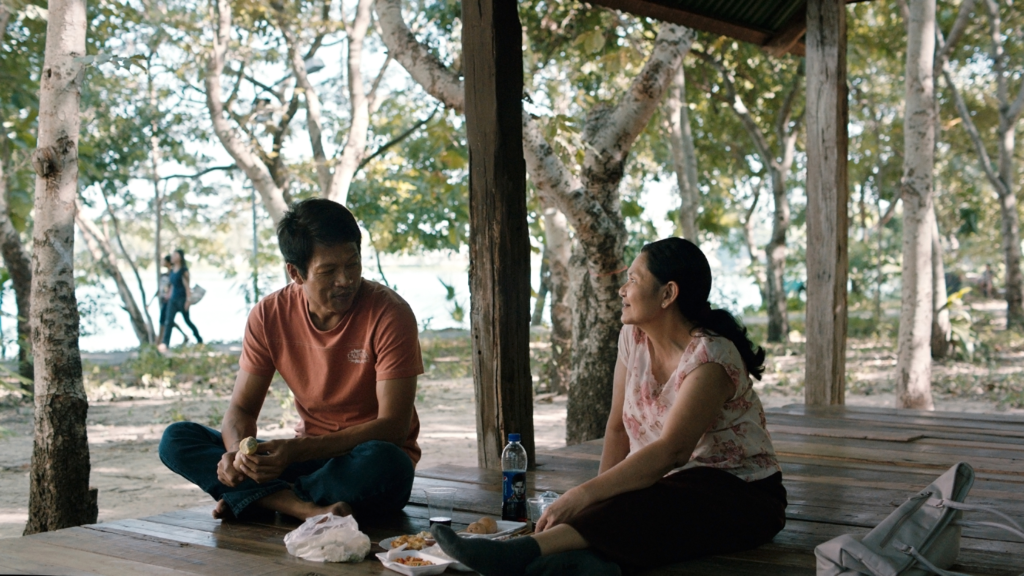
Although Cemetery’s preoccupation with physical pleasure is no doubt genuine, understanding how this affect relates to its political undercurrents may help account for how Weerasethakul can call it a ‘movie of resistance’. This film, like his others, is invested in the notion that the past underlies the present, but this conviction occasionally shifts into the implication that any given surface has deeper, perhaps sinister, currents swirling underneath. In one brief scene, a man visits a medical clinic, where he learns that he has a parasitic worm wriggling under the skin of his chest; the doctor advises him to eat less pickled meat. The film opens with a shot of construction crew excavating a field near the sleeping soldiers’ clinic – which is variously, and incidentally, explained as a project to lay fibre-optic cable, and, as casually speculated by Jen, a secret government scheme that will one day see the local population ushered out of the area. As moments like these quietly accumulate, Weerasethakul seems to be hinting that everything we know – the present, our bodies, the ground we stand on – may be poised to drop out from under us.
This sense of reality as a series of constantly shifting states is best articulated in the neon-light fixtures attached to the soldiers’ bedsides, which wash their room in a slowly changing spectrum of colours: these are the film’s most beautiful images, but their narcotising effect has worrying implications. During the climactic tour through the Khon Kaen park, Jen admits to Itt/Keng that she’s no longer sure whether she’s dreaming, or how to wake up – she’s told, perhaps facetiously, to open up her eyes as wide as she can. Cemetery’s final image finds her doing just that, staring out over the mounds of excavated dirt the construction crew has piled near the clinic. The moment is a troubling cap on the film’s otherwise-gentle preoccupation with the porousness of reality: it suggests that the sleeping soldiers represent not just the government, as Chang suggests, but the entire country. In a realm of constant, anaesthetising phase change – where sleep bleeds into consciousness, past into present, and government into government – it’s easy to lose your grip.
Endnotes
| 1 | Thunska Pansittivorakul, ‘A Conversation with Apichatpong Weerasethakul’, Criticine, 29 April 2006, <http://www.criticine.com/interview_article.php?id=24>, accessed 19 February 2016. |
|---|---|
| 2 | Apichatpong Weerasethakul, quoted in Amir Ganjavie, ‘A Homeland Swansong: Apichatpong Weerasethakul on Cemetery of Splendor’, Senses of Cinema, issue 77, December 2015, <http://sensesofcinema.com/2015/feature-articles/apichatpong-weerasethakul-interview/>, accessed 19 February 2016. |
| 3 | Genevieve Yue, ‘Light of the Century’, Reverse Shot, 27 December 2009, <http://reverseshot.org/symposiums/entry/9/5_syndromes_and_century>, accessed 19 February 2016. |
| 4 | Chico Harlan & Lennox Samuels, ‘Thai Military Declares a Coup, Detains Key Political Leaders’, The Washington Post, 22 May 2014, <https://www.washingtonpost.com/world/asia_pacific/thai-military-declares-a-coup-detains-key-political-leaders/2014/05/22/5da6a6ca-e1a0-11e3-8dcc-d6b7fede081a_story.html>, accessed 19 February 2016.v |
| 5 | Justin Chang, ‘Cannes Film Review: Cemetery of Splendor’, Variety, 18 May 2015, <http://variety.com/2015/film/asia/cemetery-of-splendor-review-cannes-apichatpong-weerasethakul-1201499533/>, accessed 19 February 2016. |
| 6 | Weerasethakul, quoted in Ganjavie, op. cit. |
| 7 | Chang, op. cit. |
| 8 | Harry Cheadle, ‘ASMR, the Good Feeling No One Can Explain’, Vice, 31 July 2012, <http://www.vice.com/read/asmr-the-good-feeling-no-one-can-explain>, accessed 19 February 2016. |
